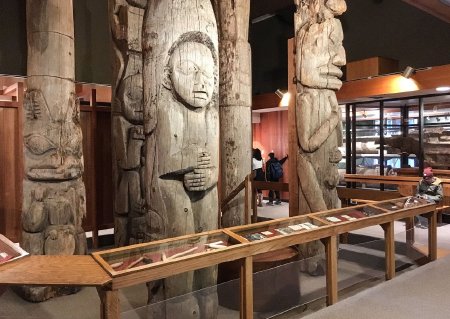Totem Poles
The monumental carvings known as totem poles in English are known as kootéeyaa in Lingít (Tlingit), gyáa'aang in Xaad Kíl (Haida), and p'tsaan in Sm'algyax (Tsimshian).
Totem pole carving is a vital form of expression for the Tlingit, Haida, and Tsimshian. Totem poles are carved for many reasons. They commemorate important events, honor the legacy of ancestors and relatives, and recall stories of clan history. Totem poles and the stories associated with them belong to the individuals and clans who raised them, and their matrilineal descendants. They express profound cultural values but are not religious and were never worshipped.
Totem poles such as these once covered the tidelines of villages up and down the coast often facing the water in front of houses and graves, connected to their individual owners and clans. Once a totem pole was raised it stood in place and was allowed to naturally decay and return to the earth. Totem poles that follow the usual process of returning to the earth do so in approximately eighty-year cycles; these totem poles have survived since the early 1800s to present themselves to you today.
These totem poles look different from other totem poles you might see, as their paint has faded and their shapes have softened from decades of wind and rain before coming inside. The totem poles preserved here stand to provide inspiration for today's carvers, and the Totem Heritage Center's classes in Northwest Coast art help to train the artists of tomorrow.

